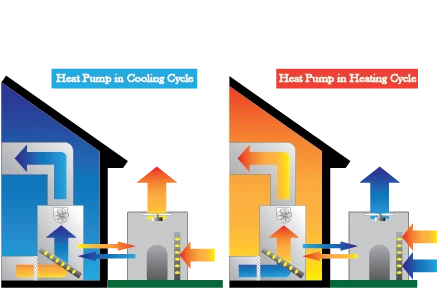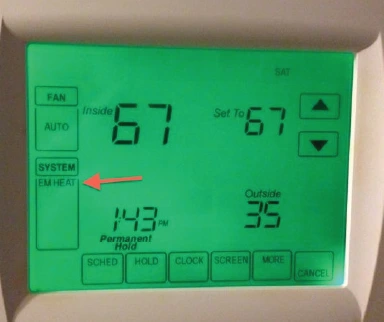What is Emergency Heat?
We love our heat pumps because they keep us warm in winter and cool in the summer. However, what happens when a heat pump can’t keep up or something breaks? Well, that’s where Emergency Heat comes in.
Emergency heat can mean one of a few things is happening, depending on how your HVAC system runs. This is a setting that you can turn on manually or that may come on automatically based on the circumstances outside.
Simply, it’s a mode of heating your home to get you through an emergency.
It is a vital setting that helps to keep your home safe and comfortable during harsh winters. Unfortunately, it also means that you can expect to pay more on that month’s energy bill.
In this post, we’ll explain what exactly emergency heat means and what is happening when you turn it on or see that light. We’ll go over the reasons it might turn on by itself and how you can make it through your heating emergency.
What Does Emergency Heat Mean?
There are two units that make up your heat pump system. The outdoor unit or compressor, and an indoor unit or air handler. Normally, the compressor pulls heat from the outside and transfers that to the air handler to warm up your home’s interior.
If you have a smart system or communicating system and the compressor cannot work for any reason, then your HVAC system will switch to Emergency Heat.
What that means is that the heat pump cannot work like normal. The outdoor unit has shut completely off, and the indoor unit is now generating heat for your home.

If your heat pump is not a communicating system, then you will first notice that you are no longer getting heat in your home. You will need to manually turn on emergency heat using your thermostat.
If you have a secondary heat source for your HVAC system, then that secondary source is now doing all the heating for your home.
Secondary Heat Sources
Usually, one of these systems will be what takes over for heating your home:
- Electric Heat Strips
- Electric Resistance
- Gas Furnace
- Oil Furnace
What’s the Difference Between Emergency and Auxiliary Heat?
If you live in a colder climate, where you can expect winters to drop below 35 degrees Fahrenheit, your heat pump is required to have one of those secondary systems. You’ve probably seen the Aux Heat light. That just means that the secondary heat source is working alongside the heat pump to keep up with the cold weather. This is normal for wintry days.
Emergency heat is for emergencies. That means that your heat pump is not working at all. Sometimes it flips on automatically. If you notice your home is getting drastically colder and your heat pump is not providing any heat, then you will need to turn it on yourself.
That being said, there are some models of thermostat that say they are running in Emergency Heat when they really are running in Auxiliary Heat. To know what your model of thermostat will say, check the user manual.
How to Turn Emergency Heat On and Off?
As we stated earlier, your thermostat can automatically switch to emergency if it detects something is wrong. However, that is not always the case, and you will need to turn it on yourself. This is a straightforward process.
There should be an Emergency Heat switch or setting on your thermostat. All you need to do is:
- Flip that switch to on, or tap the button to activate it
- Call your HVAC company to let them know your heat pump is not working
- Switch your emergency heat off when your emergency is over

Reasons to Turn On Emergency Heat
You should only use emergency heat for emergencies. If your thermostat has not automatically switched to emergency heat, there are some causes in which case you should switch to emergency heat. Keep in mind, emergency heat is less efficient than the heat pump’s normal heating system, so you should not turn it on just because it is cold out.
Here are some reasons you should turn on emergency heat:
- Your heat pump has iced over
- A tree limb or windblown debris has damaged your heat pump
- A cold snap has pushed the temperature too low for your heat pump to keep up or has damaged your heat pump
Cost of Running Emergency Heat
Running emergency heat is less efficient and more costly than how a heat pump system normally runs. This setting puts all the burden of heating your home on your secondary heat system, which is normally not as efficient as your heat pump.
If you have an all-electric heat pump system, then you do not have a furnace as a secondary heat source. Instead, the air handler will use electric resistance or heat strips to become an electric furnace. This method of heating is very inefficient and will increase your energy cost by a substantial amount.
If you have a gas or oil furnace as a backup heat source, then your cost for fuel and energy will increase, but not as much as an all-electric system.

The amount your cost goes up depends on your normal energy usage and how cold the weather is. It is impossible to know for sure. You can use an online calculator to get a rough estimate. Unfortunately, there’s no way to know for sure until you get your energy bill.
When HVAC is Stuck in Emergency Heat?
If your thermostat detects that something has gone wrong, then it can switch your HVAC system over to emergency heat without you flipping the switch. It’s possible that your heat pump has just iced over and needs to defrost. This is normal in cold climates and it should switch out of emergency heat once it has defrosted.
If it stays in emergency heat mode, or you notice that something else has gone wrong, then you will need to contact an HVAC professional for emergency repairs.
Being in this state means that the heat pump is not working at all, and that your air handler or back up furnace is doing all the work. Your system can run in this state for a long time without problem, but it will use a lot of power to do so. That means that your energy bill will be significantly higher than if it was running normally.
You need to contact your local HVAC professionals and let them know that your thermostat’s emergency heat light is on and that you suspect something broke.
Who Are Advantage Heating and Air Conditioning?
We are your local HVAC Experts out of Salem, Oregon. We hope that this post gave you the information you need about what your thermostat’s emergency heat setting is. If you have other questions about HVAC systems, check out our other blogs. To learn more about who we are and how we can help you, visit our website and follow us on social media – we’re here when you need us!







